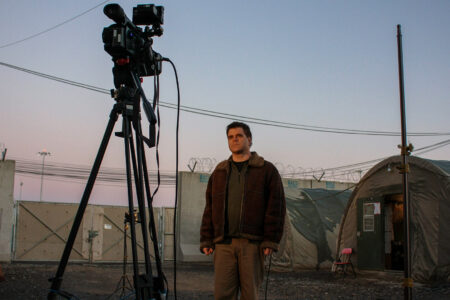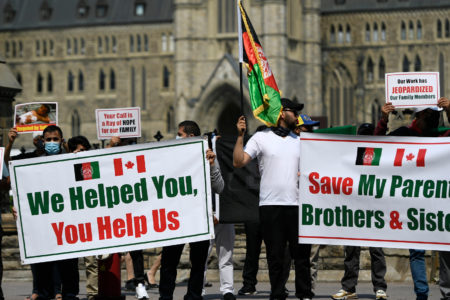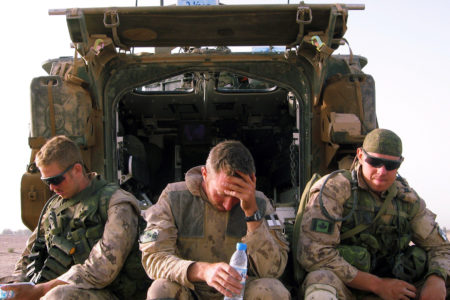
The day is stamped in my mind as a landmark. I think back to a bitter cold day in Kabul four years ago. Not too far into the autumn, winter arrived unexpected- ly early in the rugged country, as if to test the commitment and interest of Afghans to usher in a new era of democracy. Rich and poor, young and middle-aged and old Afghan men and women showed a determined resolve that day, lining up to vote for their first president and taking the epoch first step to building a democratic nation.
Women, clad in bluish mauve burkhas, stood shivering- and for hours ”” with babies in their arms. Teenaged girls in light head covers, minding toddler siblings, stood around smiling as proud spectators of their mothers’ usage of vot- ing rights, a right never before granted to women in the country’s history. Afghan men in their majestic turbans jos- tled, indulgent of the women’s enthusiasm, while they wait- ed patiently to cast their own ballots. This was a memorable day in the life of Afghanistan, with universal adult suffrage in full display ”” a glorious day in democracy’s advance.
But has the election, which we flaunt as the best expres- sion of democracy, been able to secure the democratic rights of the people, promoted human rights and made provisions for human security? Part of the answer lay in the turnout of Afghans to the national parliamentary election a year later in 2005, when a lower number of people cast their ballots and with less enthusiasm. The answer is reflected in public polls and private conversations with Afghans at various lev- els. Today, Afghan dreams of 2004 are shattered.
Afghans have no interest in going back to the Taliban regime. They are disappointed with the deteriorating security situation and fearful of Taliban advances. Driven by their fears, they consider army presence necessary for estab- lishment of initial security. But they are not in favour of con- tinued and indefinite long-term presence of foreign troops in their country. They long to see increased visibility and pres- ence of their own government in governance. They disagree with the claims of foreign troops about progress achieved in winning the war. They question the sensibility of the argu- ment that increased suicide bombing is an indicator of the Taliban losing ground. They regard use of this indicator as reflective of the insensitivity of the international communi- ty to the Afghan people’s plight, as suicide bombings contin- ue to take tolls on Afghan civilians. Afghans consider human security non-existent when the life of a little boy, playing on the rooftop of his mud house 10 kilometres away, ends from a bullet aimed to assassinate the president of the country, or when a father whose opium poppy crop has just been eradi- cated cannot pay the drug lord who supplied the seeds and the in-kind pay- ment is his 14-year-old daughter.
In 2001, the objective set by the inter- national community was to build a new Afghan nation through promoting reconstruction, reform and develop- ment that would improve the stability and security environment and expand the Afghan government’s legitimacy.
Afghans dreamed of such a secure nation and poured their hearts into electing a president to lead them. Their dreams are shattered not because their material well-being has not been met. In fact, given the nearly zero base capacity with which the Afghanistan Transitional Government started, progress in the post-Taliban period in social and economic sectors to promote delivery of basic services, albeit limited, has been commendable and surpassed the achievements of other south Asian countries within the first five years of their independence. Afghanistan’s progress must not be underestimated.
Despite its weak capacity, the Afghan government has not totally failed to deliver to its people. Significant positive results have been achieved to date in social and economic sectors that are well publicized. What is less known, however, is that these programs provide concrete evidence of Afghan govern- ment’s successful development delivery. These programs have been designed and implemented by the Afghan govern- ment, which is so often loosely accused of corruption, and often without much supporting evidence.
Common Afghans mostly acknowledge such modest progress and do not necessarily expect any miraculous recovery from age-old poverty conditions. But they consider human security to be essential and a priority for the government to deliver.
Afghans are aggrieved to see the fail- ure of the elections, attained with an investment of over $130 million, to deliver true democratic governance. The basic rights of the citizens remain unpro- tected, in the absence of an honest and well-trained police cadre assuring physi- cal security and a modicum of a justice system. In the interest of chasing a rather superficial indicator of democracy ”” the elections ”” the international communi- ty ignored a very fundamental problem: the lack of state institutions capable of implementing a monopoly of power and a unitary legal order, so essential for pro- tecting the democratic rights and securi- ty of the people.
The prescriptive and self-serving nature of aid to Afghanistan, sup- porting military and political objectives of the donor, is clearly reflected in the practices of the troop-contributing coun- tries directing a disproportionate amount of aid to the southern provinces where their troops fight insurgencies to estab- lish security. Yet, in the interest of addressing the political objectives of the Bonn agreement, which was overly influ- enced by the governments of the north- ern countries, the security sector reform, the prerequisite to stability, became a sec- ondary affair in the aftermath of the war of 2001. The Afghan security forces and the army are yet not strong enough to resist aggression. The police force is unable to win the trust and confidence of the people. Reforms to the Ministry of Interior have not been implemented. Access to justice is non-existent. Poppy cultivation is ever expanding, indicating failure of the international community’s drug control strategy. Disarmament and Demobilization of the regular militia remain incomplete because of the failure of the reintegration of the demobilized soldiers within the fold of the civil socie- ty. In fact, rearmament of these soldiers and their collusion with the warlords are posed as strong possibilities. On the other hand, the Disarmament of the Illegal Armed Groups (DIAG) has hardly advanced. In general, as opposed to the relatively successful program delivery in the social sectors, security sector reforms have ended in failure except in the case of the army, and that also only partially.
An objective develop- ment practitioner can- not but agree that the international community has failed to deliver in Afghanistan. It failed to deliver in its commitment to build a new Afghan nation, and provide human security through promoting reconstruction, reform and develop- ment that would improve the stability and security environment and expand the Afghan government’s legitimacy beyond Kabul and across the nation.
Let us consider a series of further exacerbating circumstances making aid ineffective: lack of donor coordina- tion, parallel delivery by donors through non-government channels (profit and non-profit private sector) with two-thirds of foreign assistance deliberately bypassing the Afghan gov- ernment, thereby undermining the government’s role in state and institu- tion building and exacerbating the capacity crisis in the government.
Some of the Afghan government’s successes in the social and economic sec- tors, such as the benefits accrued from the National Solidarity Program (NSP), micro-credit dispensation and stabiliza- tion of the Afghan currency, bear evi- dence of the extent of success that can be reached with harmonized and well- coordinated donor support to and investment in Afghan-initiated reforms and associated programs. They suggest that the legitimacy crisis of the Afghan government could be abated with the leadership role taken by Afghans and a coordinated donor strategy supporting the leadership. Instead, domination of Afghanistan’s development and institu- tion building process by the internation- al community has ”œtilted the entire process of nation building into a decline from which Afghanistan may not ever recover.” International community’s response to development and institution building needs is largely uncoordinated.
Despite the rhetoric of coordina- tion through addressing the Afghanistan Compact benchmarks, it is quite clear that the international community has no shared vision, much less a common strategy. The international community’s appetite to develop and follow a coordinated Joint Assistance Strategy, in support of the Afghanistan National Development Strategy (ANDS), is yet to be tested.
So should be tested the credibility and commitment of the UN Mission in Afghanistan to undertake coordination tasks. Acknowledging that the UN has not succeeded in delivering on this count, its leadership should strive to make the critical coordination process a reality.
To stabilize and secure the state, the international community in unison must develop firm strategies and guidelines to address the central objective of the Afghan mission, through the use of the defence, diplo- macy and development instruments. No projects, programs, actions and dialogue should be approved and implemented without screening them through the lens of the strategic objec- tive of increasing the Afghan govern- ment’s visibility in exercising the sole power of governance and strengthen- ing the government’s control and hold of its territories. Successfully address- ing the strategic objective of stabilizing Afghanistan and legitimizing the authority of the Afghan government, will ultimately determine the effective- ness of international aid.
No clear strategy has yet been estab- lished by the international community and shared with the Afghan government or the public of Afghanistan and those of the Western nations, except the make- believe one that quick impact and visible projects will win the hearts and minds of Afghans, neglecting to accept that such QIPs (quick impact projects) may earn temporary force protection for the troops contributing countries but will soon turn into NIPs (no-impact projects) as they do nothing to earn long-term legitimacy for the Afghan government.
Financing of national programs, designed and delivered by the Afghan ministries, on the other hand, does earn the support of the people. There is evi- dence of that. The national programs are also management-efficient instruments for development service delivery, when compared to bilateral project assistance mechanisms. The national programs are planned as large sector-based programs and are financed through multilateral organizations. Accountability and reporting mechanisms are built in. If these are not found adequate by the donor gov- ernments, tighter accountability require- ments might be demanded. But just for the sake of tracking each donor dollar, parallel bilateral project interventions will manage only to undermine the gov- ernment-delivered programs and with them the government’s authority. The international community must observe the ”œDo No Harm” principle by avoiding an approach that is counterproductive to the objective of expanding the Afghan government’s legitimacy. Donors should rather bring value-added to multilaterally financed programs through inputs into critical policy dialogue and influencing critical reform directions and actions.
At the base of the state building agenda lies capacity building. With a $1.6-billion investment in capacity building, the international commu- nity has failed to build sustained capacity in the critical Afghan min- istries and institutions. Capacity buy- ing and replacement for quick and easy management solutions have failed to build sustained capacity. Little has been said to date of the eth- ically and tactically wrong practice of the international community chan- neling 40 percent of the aid to Afghanistan to benefit costly expatri- ate consultants. A slew of overpaid, inexperienced and untrained recent graduates from the northern counries have used ODA resources to develop their own capacity working in the ever-expanding ”œaid industry” that has engulfed Afghanistan. The process of building capacity must be reassessed and knowledgeable techni- cal assistance provided with under- standing of Afghanistan’s society and culture and of the identified needs and priorities.
Dangers associated with overesti- mating the utility of ”œvolumes of aid” in terms of both commitment and dis- bursement, should not be over-looked. A higher volume of aid will not neces- sarily lead to better results unless other factors debilitating aid effectiveness are addressed. Besides, high volumes of aid generate aid dependency, which in the long term ties a recipient government to foreign donors. A government should be accountable to its citizens. A very large and ever-increasing aid depend- ency tends to transfer the government’s accountability from the people to donors, which is undesirable.






